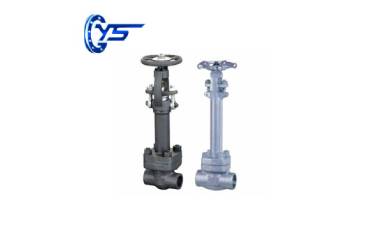In the process of designing a low temperature valve, in addition to the general requirements such as the flow capacity and flow path resistance of the low temperature valve, other indicators need to be considered in order to better evaluate the technical level of the low temperature valve. Generally, the technical level of the low temperature valve is evaluated by measuring whether the energy consumption is reasonable. The main evaluation indicators are as follows.
1 Thermal insulation performance of low temperature valve
The thermal insulation capacity of the low temperature valve can be measured by using the mass ratio of the heat flow Q1 of the valve entering the low temperature medium to the low temperature medium passed. However, when the type of medium is unchanged and its value changes only when the flow rate changes, it is obviously inappropriate to use this method as an index for evaluating the thermal insulation capacity of a low temperature valve. KT can be used for unified comparison.
2 Cooling performance of low temperature valves
The cooling performance of the low temperature ball valve refers to the ability of the low temperature valve to cool from normal temperature to the working temperature. This performance can be measured by the energy consumed by the valve in the above process, that is, the heat Q2 transmitted by the valve to the low temperature medium in the above process. For periodic low-temperature valves, the cooling performance index is of great significance. But just using Q2 to measure the cooling performance of low temperature valves is not enough.
3 Working performance of low temperature steel gate valve
Under low temperature conditions, the performance of the seal is often damaged. In order to achieve a reliable seal, a reasonable seal structure or a larger specific pressure of the seal must be adopted. Therefore, it is necessary to evaluate the sealing effect.
4 Freezing conditions on cryogenic valve surfaces
When the cryogenic valve is working, its surface should not be dew condensation, nor should it be frozen. Whether the outer surface of the valve freezes depends first on the difference ΔT1 between the ambient air temperature and the surface temperature of the components, and secondly on the dew point temperature of the air. In fact, it is difficult to completely eliminate condensation under all weather conditions. However, if ΔT1 meets certain conditions, the possibility of icing will be greatly reduced, and the condition that the valve surface is not icing is ΔT1 ≤ 5 ° C.
As the nominal diameter increases, the performance of the valve improves. Therefore, the requirements for Kr and Km indexes should be changed according to the different nominal diameters. The value of Km also depends on factors such as the type of valve, the material of the valve housing and the structural integrity of its components. Generally speaking, the Km index of the butterfly valve is the best, but the low-temperature sealing performance of the butterfly valve is not very good, so it is only used to adjust the medium flow; the performance of the shut-off valve and the gate valve is second, and the low-temperature sealing performance is better.

Low Temperature Steel Gate Valve
Copyright © Hebei Yaosheng IM & EX Trading Co.,Ltd. All Rights Reserved |Sitemap | Technical Support: 
